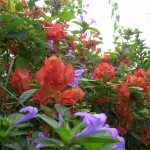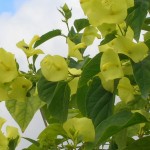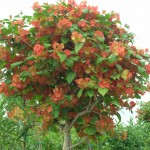Mandarin Hat Plant (Holmskioldia sanguinea)
The management and staff of Richard Lyons’ Nursery always make a sincere effort to urge customers to use both scientific and common names of plants. But considering how hard it is to say Holmskioldia sanguinea, we’ll forgive you if you favor the common names, Mandarin Hat Plant (the name preferred in southern Florida), Chinese Hat Plant or Cup-and-Saucer Plant.
This Asian shrub belongs to the Lamiaceae, an interesting family — comprising about 3,200 species — which includes not only herbs such as rosemary, oregano, lavender, thyme, basil, sage, catnip and mint, but also trees such as teak. H. sanguinea is a climbing shrub native to the lowlands of the Himalayas. The plant grows fairly rapidly to about 6-10 ft. high and about as wide. It can exist unsupported, but can also be grown on a trellis or fence. It occupies a niche in the landscape both as a hedge and as a specimen plant.
H. sanguinea flowers most heavily between October and May. Each hat- or saucer-shaped flower features orange-to-scarlet petals and a red, orange or yellow calyx. If you want to maintain the plant’s compactness, do some selective pruning after it flowers.
The Chinese Hat Plant should be grown in full to partial sun. It prefers a well-drained soil. Once established, it is reasonably drought-tolerant, and, in fact, its moisture demands are not as great during the winter. It is moderately salt-tolerant and can handle some frost.
In addition to the red, orange and yellow forms of H. sanguinea, we also recommend a related species, H. tettensis, a blue-flowering species which blooms in the summer. Both of these Holmskioldia species are available at the nursery in 3-gal. containers. We also grow them as standards.



![holmskioldialavender[1]](http://www.richardlyonsnursery.com/wp-content/uploads/2013/03/holmskioldialavender1-150x150.jpg)
